MS 000007 : Clifton Hill to Northcote and Preston Tram Company Limited : correspondence 1887-1890
By Benjamin Petkov
Each major city has their fingerprint. A combination of factors that make that place, distinctly there. Melbourne is a fine example of this. One can experience Australia – however that doesn’t specifically mean that they’ve experienced Melbourne. Whether it’s the seamless joining of heritage and contemporary, the gardens or the food – there will always be a distinction between Melbourne and Australia’s other major cities. However, one chimes true, immediate and clear. In the distance, one will always hear the ding of a tram, with the whoosh of electric motors, and the steady rumble of steel wheels on tracks.
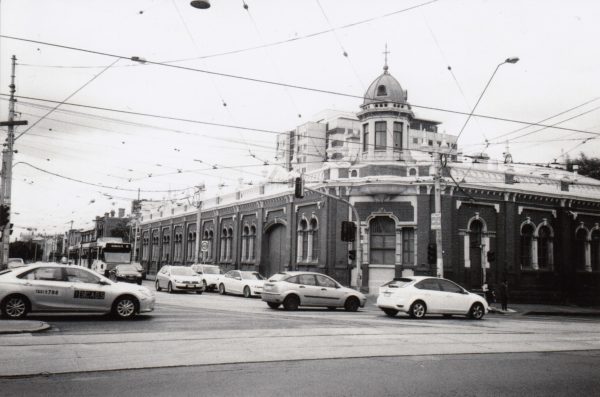
Melbourne’s tram system is largely attributed to Francis Boardman Clapp, an American-born entrepreneur who came to Australia with grand plans of striking gold, but sooner found success in establishing Melbourne’s first bustling public tram-system. However, Clapp and the Melbourne Tramway and Omnibus Company wasn’t the only company constructing Melbourne’s mechanized tramways. No, one other company was operating at the same time. The rather long winded “Clifton Hill to Northcote and Preston Tramway Company”, to be referred to from here on out as the C.H.N.P.T.C., is credited with the initial construction, and collapse of the Clifton Hill line. Recorded as having initially opened for service in 1887, the Clifton Hill line would fall into multiple different leases, would lose money and make money, and would fall into a state of ramshackle notoriety – but ultimately, the Clifton Hill line, for all its shortcomings, would continue to operate longer than any other Melbourne cable tram, open to the public from 1890 to 1940, where the line was later converted to electric rail.
Two years ago, Melbourne was celebrating the 130th anniversary of its first Cable Trams, established in 1885. The discourse of the time was one of excitement, but within the C.H.N.P.T.C., there was the rush to set up tracks and lay cable, to connect Clifton Hill, Northcote and Preston not only with each other, but with the already established Hoddle Grid. One needn’t look any further than the letters held by the R.H.S.V. to see this rush. Here one finds correspondence between local councils and the C.H.N.P.T.C., intermingled with contractors, bankers, stock brokers and engineers. Nearly all letters are either addressed directly to the head secretary for the C.H.N.P.T.C., W.S. Forbes, or are signed off by him. In this, one has a direct view into the inner-workings of the company, immediately before its foreclosure to the English, Scottish & Australian Chartered Bank in 1893. In this, all correspondence rests between the founding of the C.H.N.P.T.C. in 1887, and its collapse in 1893. This in itself works to accent the supreme historical importance of these letters – where they work to shine a light on: early Australian industry, the establishment of our State’s first mechanized tram system, and the establishment of our state’s outer suburbs.
The collapse of the C.H.N.P.T.C. can be partially attributed to the company’s inability to hold onto money. Where their counterparts, The Melbourne Tramway and Omnibus Company, were an already established and functioning company in 1867, and were in turn able to ride out the collapse of the housing boom of the late 19th century. However, the C.H.N.P.T.C. entered the market at the height of the boom, relying on the private coffers of individual members, the profits of the Northcote Brickworks, and bank loans to fund their works. In this, one need but look to the back-and-forwards correspondence between the C.H.N.P.T.C. and the English, Scottish & Australian Chartered Bank to recognize that by 1890, they were borrowing huge amounts, and losing money – fast.
“Dear Sir – I am instructed by my directors to request that you will be good enough to reduce rate of interest chargeable to this company from 8.90 to 7.90 as you are aware we have had to contend with so many unexpected liabilities and it will be some time yet before our line will be open for traffic – trust you will endeavor to comply with this request which is not an unreasonable one, as I have been informed in several instances that other banks are charging 7.90 at present on advances. – Yours truly, W.S. Forbes.” – 18th November 1889. [letter below left]

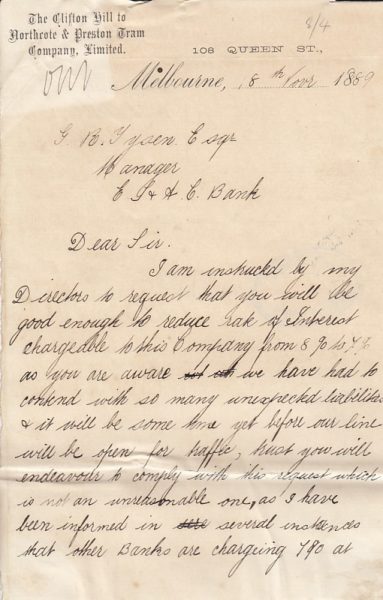
[letter above right] “W.S. Forbes – Dear Sir – Referring to a conversation of yesterday the Bank is writing to grant the additional advance of 5000 (five thousand pounds) asked for on the condition that the directors undertake to make cases for the repayment of much extra advance whenever called upon to do so. – G. R. Eysseu – Manager” – 18th December 1889.
The C.H.N.P.T.C. was losing money, and borrowing huge amounts in an effort to keep up with “unexpected liabilities”. Money was being spent on establishing infrastructure, as seen with: the widening of the Rucker’s Hill embankment and the Widening of the Northcote Bridge over Merri Creek.
[letter below left] “D. Sir – I enclose receipt for sum of £1000 being portion of sum payable towards widening the Ruckers Hill with thanks. – Yours obediently, W.G. Swift – Town Clerk.” – 9th April 1889.

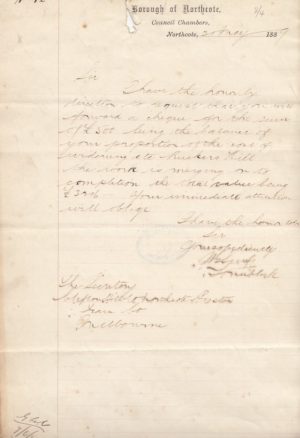
[letter above right] “Sir – I have the honor by distinction to request that you will forward a cheque in the sum of £500 being the balance of your proportion of the cost of widening the Ruckers Hill – the work is merging on to completion the total value being £3216 – your immediate attention will oblige. – I have the honor to be, Sir, yours obediently – W.G. Swift – Town Clerk.” – 30th May 1889.
[letter below left] “Sir – I have the honor to acknowledge the receipt of yours of 8th inst, requesting the appointment of delegates to attend a conference on widening Northcote Bridge, and am directed to inform you that half of such bridge being within this Borough [Northcote] this council is entitled to half the representation at such conference. His Worship the Mayor (Councillor Yeomans), Councillors Bastings, Plant, and Dennis have therefore been depicted to represent this Council therein. – I have the honor to be, Sir, your obedient Servant – W.G. Swift – Town Clerk.” 12 January 1889.

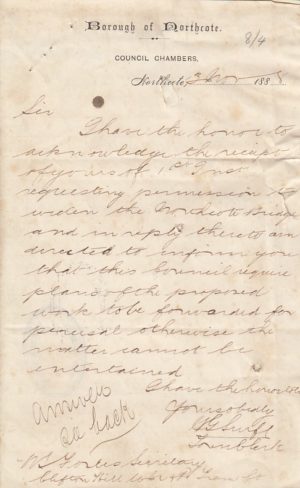

[letter above centre] “Sir – I have the honor to acknowledge the receipt of yours 1st August requesting permission to widen the Northcote Bridge and in reply thereto am directed to inform you that this council requests plans of the proposed work to be forwarded for perusal otherwise the matter cannot be entertained. – I have the honor to be, yours obediently – W.G. Swift – Town Clerk.” 3rd of November 1888.
[letter above right] “G. S. Duncan Esq. – Dear Sir – I am instructed to request that you will authorize to W. Hiskland to proceed with the necessary alterations to Northcote Bridge. – Anon” – 6th December 1889.
The C.H.N.P.T.C. was losing money, and the line wasn’t yet open for traffic. In this, not only were they contesting with costs for infrastructure, but with patents and engines – and bureaucracy.
[letter below left] “Sir, – In reply to your letter of the 20 the September I am instructed to state the Directors of this company will be prepared to give to your company the use of the patents for the cable lines for the lump sum equal to £150 per mile of tramway cable laid. – I am Sir – Yours obediently” – Melbourne Tramway and Omnibus Company (Limited). – 25th September 1888.
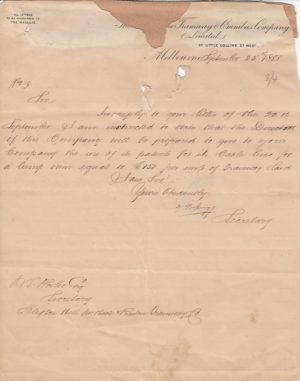

[letter above right] “Dear Sir – We will be glad to (regard) if cheque is available for balance of contract for supply of engines – We understand our … has turn passed by the engineers – that for the pumps some time ago. – Yours faithfully – M. Symonds.” – Austral Otis Elevator & Engineering Coy. Ltd. – 9th April 1890.
However, though expenses were mounting, the line was opened to traffic on the 18th of February, 1890, at a total construction cost of £90,000. Dollies and carriages used were constructed new by the M.T.O.C.. In 1892, the collapse of the land boom brought the closure of the Northcote Brickworks, and the company lost a major financial foothold. The C.H.N.P.T.C. was in turn seized by the English, Scottish & Australian Chartered Bank in 1893, after a combined loss of £10,414 over their last two years of operations. Northcote Council would go on, under public duress, to purchase the line back from the bank for the lump sum of £3,500, on top of a further £12,285 put in place to refurbish the line. From 1901 to its absorption by the Melbourne Metropolitan Tramway Board in 1920, the line would go on to be run by multiple leaseholders, and to finally turn a profit.
Further Reading
Russell Jones’ piece on the C.H.N.P.T.C.
Gary Vines’ 2012 study into Melbourne’s Tramway History
RHSV catalogue : Correspondence, 1887-1890, re construction of cable tramway

 239 A'Beckett Street Melbourne, Victoria, 3000
239 A'Beckett Street Melbourne, Victoria, 3000  03 9326 9288
03 9326 9288  office@historyvictoria.org.au
office@historyvictoria.org.au  Office & Library: Weekdays 9am-5pm
Office & Library: Weekdays 9am-5pm

